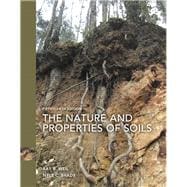Developed for Introduction to Soils or Soil Science courses, The Nature and Properties of Soils, Fifteenth Edition, can be used in courses such as Soil Fertility, Land Resources, Earth Science and Soil Geography.
"The Nature and Properties of Soils has been my labor of love for the past 5 years and updates a narrative that has both reflected and helped to shape soil science thinking for more than a century. It has evolved to provide a globally relevant framework for an integrated understanding of the diversity of soils, the soil system and its role in the ecology of planet Earth." - Ray R. Weil
This hallmark text introduces the exciting world of soils through clear writing, strong pedagogy, and an ecological approach that effectively explains the fundamentals of soil science. Worked calculations, vignettes, and current real-world applications prepare readers to understand concepts, solve problems, and think critically. Written for both majors and non-majors, this text highlights the many interactions between the soil and other components of forest, range, agricultural, wetland and constructed ecosystems.
Now in full-color, the Fifteenth Edition includes hundreds of compelling photos, figures, and diagrams to bring the exciting world of soils to life. Extensively revised, new and updated content appears in every chapter. Examples include: coverage of the pedosphere concept; new insights into humus and soil carbon accumulation; subaqueous soils, soil effects on human health; principles and practice of organic farming; urban and human engineered soils; new understandings of the nitrogen cycle; water-saving irrigation techniques; hydraulic redistribution, soil food-web ecology; disease suppressive soils; soil microbial genomics; soil interactions with global climate change; digital soil maps; and many others.










